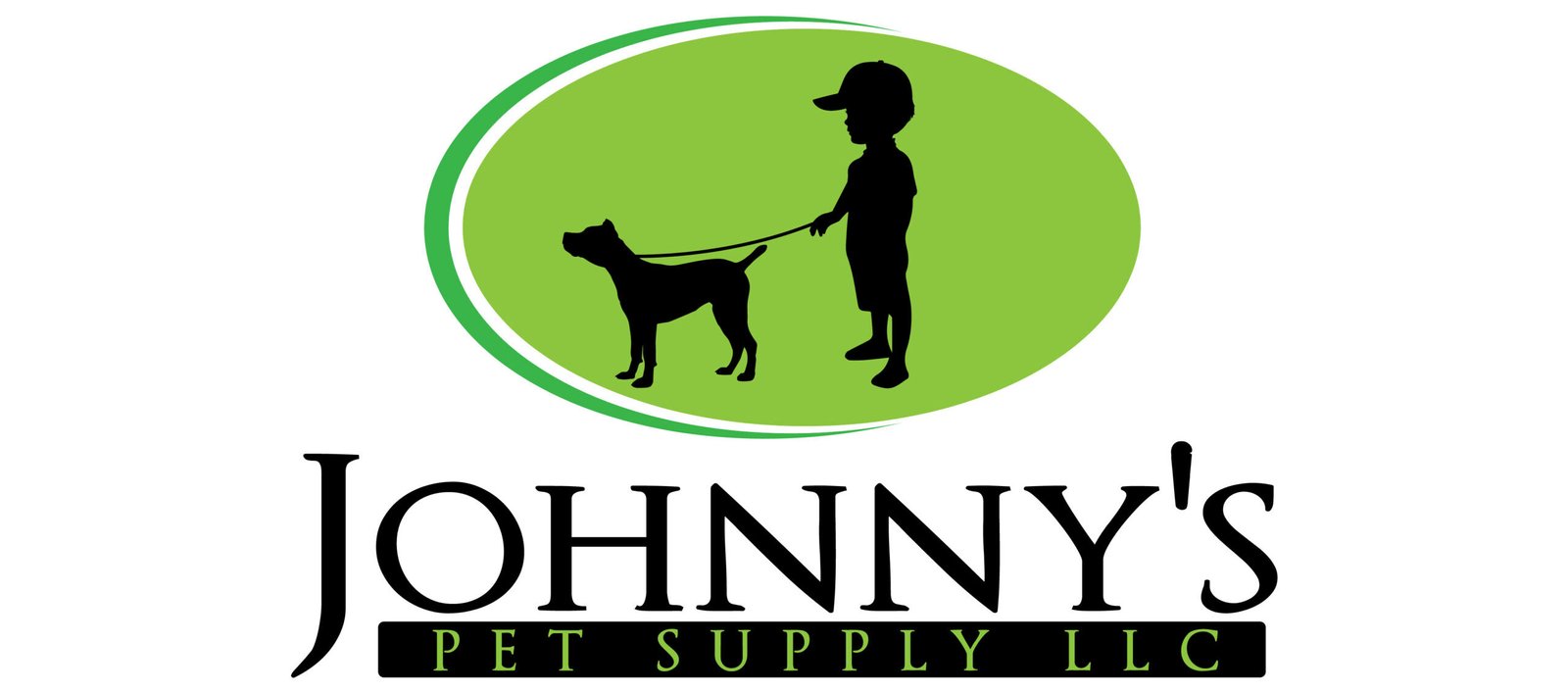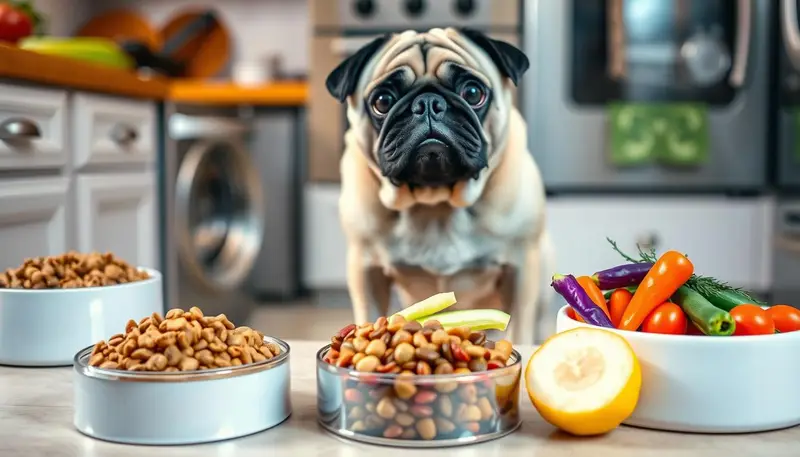How to avoid introducing too much new food to your Pug’s diet
Changing your Pug’s diet needs care. Suddenly switching foods can upset their stomach, leading to vomiting, diarrhea, and less appetite. It’s best to slowly introduce new foods over 5-7 days.
This gradual change lets their body adjust. Start by adding a little of the new food and reduce the old one. Watch how your Pug reacts closely. Some Pugs might need more time, especially if they’re sensitive or have allergies.
Why Gradually Transition Your Pug to a New Diet?
Introducing new food too fast can upset your Pug’s stomach. This can cause vomiting, diarrhea, and a loss of appetite. To prevent these problems, slowly introduce the new diet over 5-7 days. This gradual change helps your Pug’s stomach adjust smoothly.
Avoiding Gastrointestinal Upset
Quick diet changes can mess with your Pug’s gut balance. This can lead to stomach issues. By slowly adding the new food, you help your Pug’s stomach adjust. This keeps your pet healthy and happy.
“Switching your dog’s food over the course of seven to 10 days is recommended. Start by offering 25 percent of the new food and gradually increase over 10 days until fully transitioned.”
Keep an eye on your Pug’s behavior and health during the change. Watch for changes in energy, bowel movements, appetite, and appearance. This helps you catch any problems early and make the right changes.
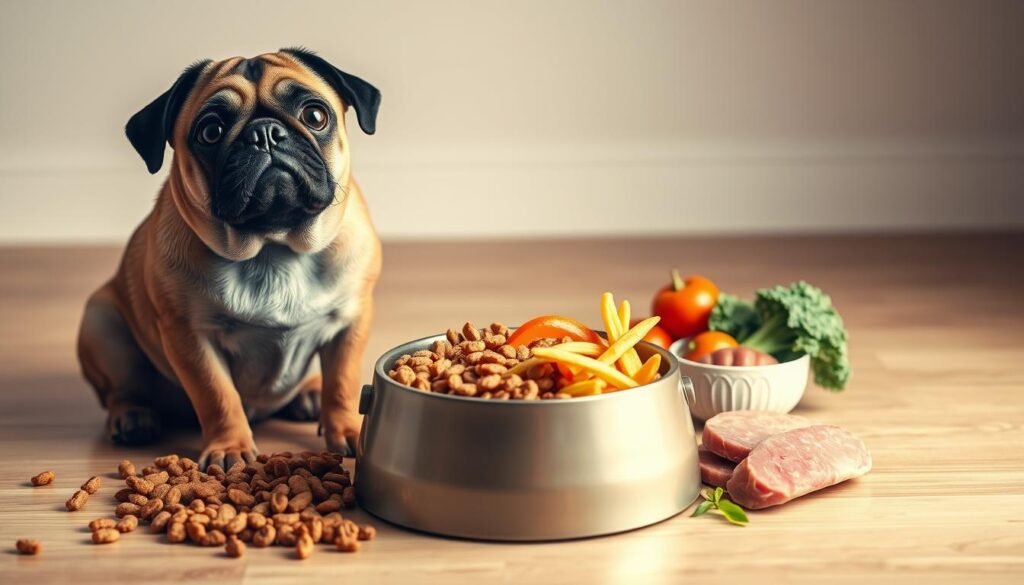
Being a responsible pet owner means taking the time to transition your Pug slowly. This approach keeps your Pug’s health and happiness in mind. By doing it gradually, you help your Pug adjust to the new food and stay healthy.
Steps for a Successful Diet Transition
Changing your Pug’s diet needs a careful and slow plan. Most dogs, like Pugs, do best with a 5-7 day transition. This means slowly adding more new food and less old food each day.
- Day 1 – 25% new food, 75% old food
- Day 3 – 50% new food, 50% old food
- Day 5 – 75% new food, 25% old food
- Day 7 – 100% new food
It’s key to watch how your Pug reacts and adjust the transition if needed. Dogs with sensitive stomachs or allergies might need more time to adjust to new foods.
Keep an eye out for signs like diarrhea or vomiting during the transition. If your Pug shows any bad reactions, slow down the change or talk to your vet. Good pet care means watching your dog’s health closely and making diet changes slowly.
By slowly introducing new food, you can help your Pug get used to it without upset stomachs. This shows the care and effort needed for a smooth diet change.
How to avoid introducing too much new food to your Pug’s diet
Adding new food too fast can upset a Pug’s stomach. It’s best to slowly change their diet over 5-7 days. This slow change helps their stomach adjust without causing vomiting, diarrhea, or loss of appetite.
Begin by mixing 75% of their current food with 25% of the new one. Gradually increase the new food while decreasing the old. By the end, they should be eating only the new food. Watch how they react and adjust the time as needed for a smooth change.
Good dog nutrition and careful gradual diet changes are key for a smooth pet food transition. This method prevents overfeeding prevention and supports responsible pet ownership.
“A gradual transition to new dog food over 5-7 days is recommended for effective adjustment.”
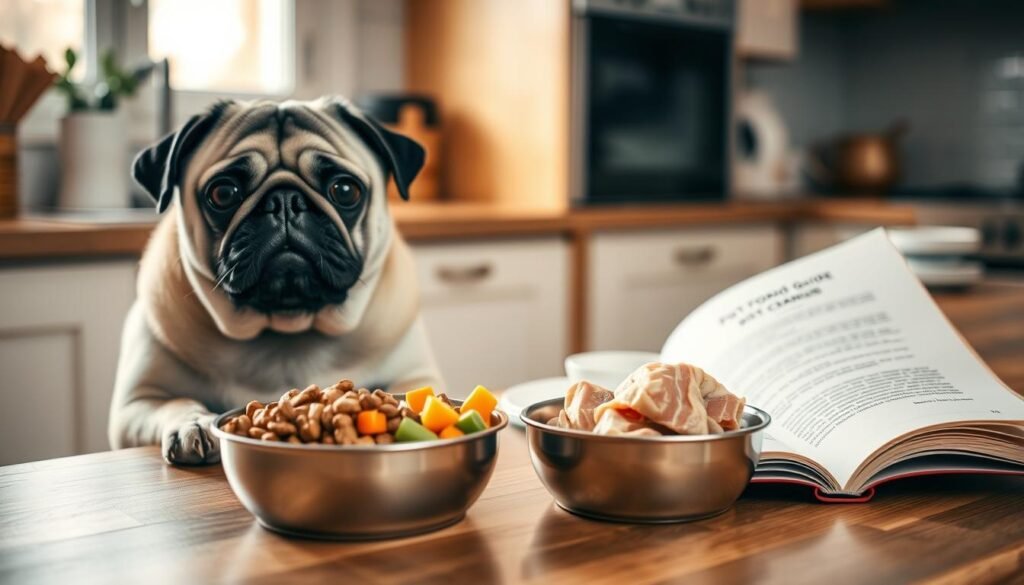
If your Pug has stomach problems during the change, go back to the old food. Slowly add the new one again. Every Pug is different, so watch them closely and adjust the time as needed.
By slowly introducing new food, you help your Pug adjust comfortably. This avoids stomach issues and keeps them healthy.
Signs of an Adverse Food Reaction
If your Pug is having digestive problems or other bad reactions, it’s key to know the signs. These signs can show up in the belly or on the skin.
Gastrointestinal and Cutaneous Symptoms
Pugs with bad food reactions might feel sick to their stomach. They could vomit, have diarrhea, or eat less. Skin problems can cause itching, inflammation, hair loss, and rashes. Remember, these signs can also mean other health issues, so see a vet if you notice them.
Studies show that food allergies can start in pets younger than 1 or older than 7 years. Also, up to 30% of pets with food allergies may have other allergies too.
- Nausea
- Vomiting
- Diarrhea
- Changes in appetite
- Itching
- Skin inflammation
- Hair loss
- Rashes
If your Pug shows any of these signs, it’s important to get them checked by a vet. This is because these symptoms can also mean other health problems. Getting the right diagnosis and treatment for digestive issues in pugs, adverse food reactions in dogs, and canine food allergies is vital for your Pug’s health.
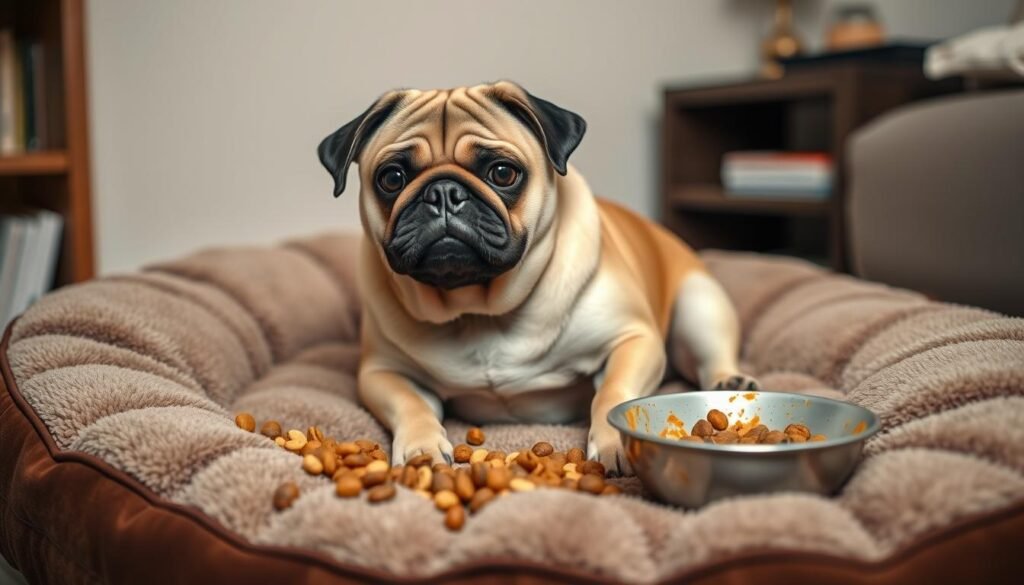
“About 50% of food-allergic dogs will not respond favorably to steroids.”
Choosing the Right Dog Food
Choosing the right dog food for your Pug can be tricky. There are many options out there. It’s important to focus on your Pug’s health and happiness. Reading pet food labels and considering your Pug’s age, health, and likes can help. This way, you can find a “complete and balanced” diet for them.
Look at the ingredients in the dog food. Stay away from fillers and artificial stuff. Choose foods with whole, natural ingredients. Also, talking to your vet can help pick the best food for your Pug, especially if they have health issues.
Different dog foods have their own good and bad points. Dry kibble is easy to use, but wet food might taste better. Raw diets are natural, but need careful planning. Homemade meals let you customize, but need a vet’s help to get it right.
The best food for your Pug depends on their needs and likes. Learning about pet ownership and canine diet management helps you make a good choice. This supports your Pug’s dog nutrition and pug health.

“The food you feed your dog is the foundation of their health and well-being. Choose wisely and consult your veterinarian to ensure your Pug thrives.”
Monitoring Your Pug’s Digestive Health
As a pug owner, watching your pet’s digestive health is key. Look closely at their stool quality. Normal changes are okay, but big changes might mean a problem.
The Fecal Scoring Chart helps you check your pug’s stool. If it’s always off, talk to your vet.
Pugs often face digestive issues because of their sensitive stomachs. Always introduce new dog food slowly to prevent upset stomachs. Symptoms like loose stools or vomiting usually go away in a day. But, if they don’t, see a vet.
Keep an eye on your pug’s digestive health to ensure they get the best dog nutrition. Good pet ownership keeps your pug happy and healthy.
Quick vs. Gradual Food Switch
As a responsible pet owner, you want the best for your Pug. When it’s time to switch dog foods, you might wonder if a quick or gradual change is better. A gradual transition is usually best for your Pug’s health.
When to Make a Quick Change
In some cases, a quick switch is needed. This might be if the current food is recalled or discontinued. Or if your Pug won’t eat their current food, or your vet says to switch right away. But, this is only for healthy adult Pugs and not for puppies or Pugs with health problems.
If your Pug refuses the new food or gets vomiting or diarrhea, go back to the old food. Then, transition more slowly. Quick changes can upset your Pug’s stomach, which is a big problem for Pugs with sensitive stomachs.
“A gradual switch is recommended when changing dog food; if a dog has been eating the same food and transitioning from one regular maintenance diet to another, a week-long transition period is advised for the GI microbiome to adjust.”
By slowly introducing new dog nutrition, you help your Pug’s stomach adjust. This shows you care about their pug health and are making a responsible pet food transition.
Finding a Similar Formula
When you’re changing your Pug’s dog food, finding a similar formula is key. This makes the transition smoother and reduces the chance of digestive upset. Look at the ingredient list and nutritional info of their current food. Try to find a new formula that matches it in protein sources, carbs, and other nutrients.
Choosing the same dog food manufacturer can also help. It keeps things consistent for your Pug. The new formula will likely taste and feel similar. This choice supports your pet’s digestive health and overall well-being.
Being a responsible pet owner means managing your Pug’s diet well. By focusing on dog nutrition and gradual changes, you ensure a smooth transition. This promotes your Pug’s health and happiness.
